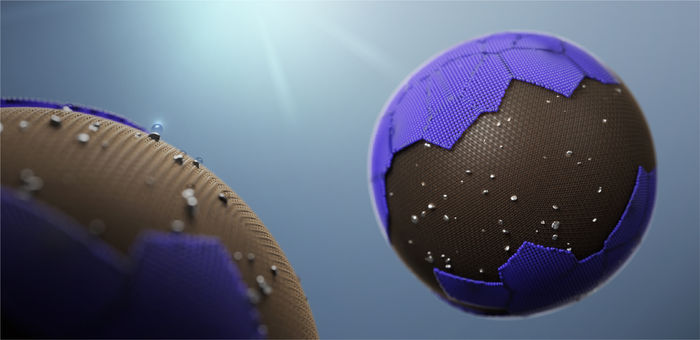Organic water splitters get a boost
Nanoparticle photocatalyst can generate hydrogen fuel from water more efficiently than their standard inorganic semiconductor counterparts
Organic semiconductor-based photocatalysts conceived by a KAUST-led team could make hydrogen easier to generate from water using sunlight.

A KAUST-led international team has developed a nanoparticle photocatalyst that can generate hydrogen fuel from water more efficiently than their standard inorganic semiconductor counterparts.
© 2022 KAUST; Ivan Gromicho
Sunlight is the most abundant source of renewable energy, but its inability to produce consistent energy levels over time means it cannot meet energy needs on demand. A promising option is to store solar energy as clean hydrogen fuel, derived from water by the so-called hydrogen evolution reaction in the presence of a light-responsive catalyst.
Most hydrogen evolution photocatalysts consist of inorganic semiconductors, such as titanium dioxide, that almost exclusively absorb ultraviolet light. But because ultraviolet light represents less than five percent of the solar spectrum, the resulting photocatalysts are not efficient enough for commercial use.
An international team led by Iain McCulloch and postdoc Jan Kosco were able to develop organic semiconductor-based photocatalysts because they could tune the semiconductor bandgaps — which define the absorption wavelength range — to absorb visible light.
“All else being equal, the more light a photocatalyst absorbs, the more efficiently it can convert solar energy into hydrogen,” Kosco explains. “So, it is important to develop photocatalysts that are active over a broad range of ultraviolet-visible-infrared wavelengths to maximize light absorption.”
When exposed to light, semiconductor-based photocatalysts generate pairs of electrons and positively charged holes, or excitons, which dissociate into free charges that subsequently can migrate to the photocatalyst surface and drive hydrogen evolution. However, excitons are tightly bound in typical single-component organic semiconductors, which restricts charge separation and photocatalytic efficiency.
The researchers combined electron donor and acceptor semiconductor materials to form nanoparticles, known as heterojunction photocatalysts, whose overall bandgap configuration promotes exciton dissociation at the semiconductor interface.
“This is analogous to the bulk heterojunction used in organic solar cells,” Kosco says. “We, therefore, generated more charges in these nanoparticles than in those composed of individual semiconductors, which improved hydrogen production.”
Unexpectedly, the heterojunction resulted in extremely long-lived photogenerated charges in the nanoparticles.
“Charges typically recombine on the microsecond timescale, but we observed charges in our nanoparticles even a few seconds after photoexcitation, which is exceptionally long for photogenerated charges in organic semiconductors,” Kosco says. This is critical for catalyst performance because it gives more time for the charges to take part in relatively slow redox reactions at the nanoparticle surface, he adds.
The team is now exploring ways to apply the new photocatalysts to water splitting Z-schemes, where hydrogen and oxygen evolution photocatalysts are coupled to simultaneously drive the production of hydrogen and oxygen. They are also developing organic semiconductor photocatalysts for oxygen evolution.
Original publication
Most read news
Original publication
Kosco, J., Gonzalez-Carrero, S., Howells, C.T. et al. Generation of long-lived charges in organic semiconductor heterojunction nanoparticles for efficient photocatalytic hydrogen evolution. Nat Energy 7, 340–351 (2022)
Topics
Organizations
Other news from the department science
These products might interest you

NANOPHOX CS by Sympatec
Particle size analysis in the nano range: Analyzing high concentrations with ease
Reliable results without time-consuming sample preparation

Eclipse by Wyatt Technology
FFF-MALS system for separation and characterization of macromolecules and nanoparticles
The latest and most innovative FFF system designed for highest usability, robustness and data quality

DynaPro Plate Reader III by Wyatt Technology
Screening of biopharmaceuticals and proteins with high-throughput dynamic light scattering (DLS)
Efficiently characterize your sample quality and stability from lead discovery to quality control

Get the chemical industry in your inbox
By submitting this form you agree that LUMITOS AG will send you the newsletter(s) selected above by email. Your data will not be passed on to third parties. Your data will be stored and processed in accordance with our data protection regulations. LUMITOS may contact you by email for the purpose of advertising or market and opinion surveys. You can revoke your consent at any time without giving reasons to LUMITOS AG, Ernst-Augustin-Str. 2, 12489 Berlin, Germany or by e-mail at revoke@lumitos.com with effect for the future. In addition, each email contains a link to unsubscribe from the corresponding newsletter.




























































